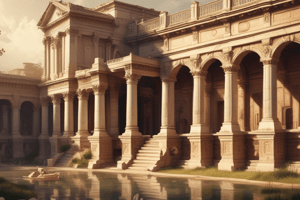Podcast
Questions and Answers
Roman architecture primarily borrowed from Egyptian precedents.
Roman architecture primarily borrowed from Egyptian precedents.
False (B)
The Pantheon's distinctive feature is its square shape.
The Pantheon's distinctive feature is its square shape.
False (B)
Roman architects introduced the Tuscan column by adapting traditional Corinthian columns.
Roman architects introduced the Tuscan column by adapting traditional Corinthian columns.
False (B)
Hadrian's Library in Athens reflects Roman architectural principles due to its construction in 132 CE.
Hadrian's Library in Athens reflects Roman architectural principles due to its construction in 132 CE.
Roman architecture has had little impact on modern design principles.
Roman architecture has had little impact on modern design principles.
Flashcards are hidden until you start studying
Study Notes
Roman Architecture and Culture
Introduction
Roman architecture is renowned for its ingenuity and endurance, shaping the landscape of European cities to this day. With origins dating back to the late First Century BCE, Roman architecture encompasses not only the physical structures themselves but also the cultural practices that informed their construction. This comprehensive guide delves deep into the history of Roman architecture and its profound impact on the modern world, exploring key themes such as building materials, innovative structures, and cultural influences.
Building Materials and Techniques
Before the introduction of concrete, Roman architects primarily relied on volcanic stones like tufa and later adopted travertine due to its enhanced durability. However, the true gamechanger was the invention of concrete, which allowed architects to push boundaries and achieve unprecedented feats. Over time, concrete became the foundation for creating larger, more elaborate structures, setting the stage for Roman architectural prowess.
Innovative Structures and Designs
One of the most notable contributions of Roman architecture is the extensive use of concrete in monumental structures. Arches and vaults enabled architects to create larger, more expansive interiors, allowing for the construction of basilicas, amphitheaters, and imperial palaces without sacrificing inner space to structural supports. For instance, the Pantheon, completed around 125 CE, showcases the brilliance of Roman engineering through its distinctive dome and oculus.
Although Roman architecture borrowed heavily from Greek precedents, the Romans introduced new ideas and refined existing ones, resulting in a diverse range of styles and forms. Their signature blend of classical elegance and creative innovation continues to inspire contemporary architecture.
Cultural Influences
The ideas and traditions of ancient Rome continue to permeate the modern world, manifesting in aspects ranging from art and architecture to literature, language, and legal frameworks. Furthermore, Roman architecture has had a powerful impact on the development of cities and urban planning. From the elegant curves of the Arc de Triomphe to the grandeur of Washington DC's Union Station, Roman architectural concepts have been woven into the fabric of countless societies around the globe.
Architectural Orders
While Roman architects followed the established architectural orders defined by the Greeks, they added their own twists. The Roman interpretation of the Corinthian capital became more decorative, while the composite capital combined elements from different orders. Additionally, the Romans introduced architectural elements like the Tuscan column, which adapted traditional Doric columns with a smaller capital and a plainer shaft.
Impact Beyond Rome
As Roman civilization expanded, its architectural techniques spread far beyond Rome itself. For example, Hadrian's Library in Athens, built in 132 CE, reflects the influence of Roman architectural principles in the eastern Mediterranean. Similarly, the Colosseum's exterior showcases engaged columns, demonstrating the spread of Roman architectural ideals throughout the empire.
Conclusion
Roman architecture has left a profound and lasting impact on Western civilization, reshaping our cities and influencing modern design principles in countless ways. By embracing innovative materials like concrete and pushing the boundaries of structural engineering, Roman architects forged a legacy that continues to inspire and shape our built environment today.
Studying That Suits You
Use AI to generate personalized quizzes and flashcards to suit your learning preferences.




